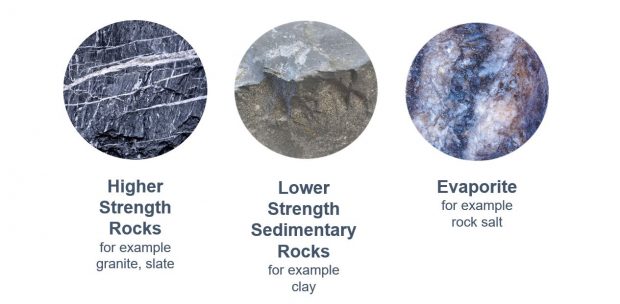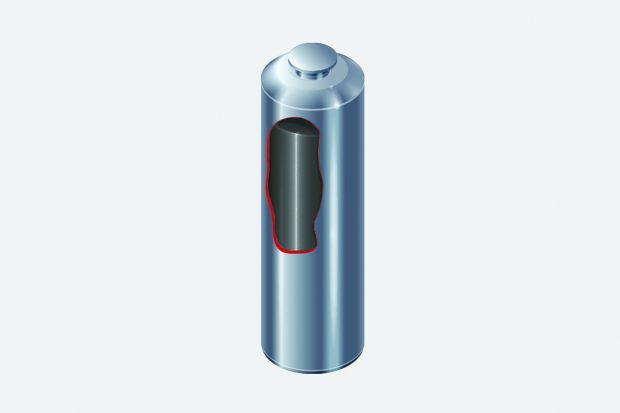Because higher-activity radioactive waste will remain hazardous to human health for a long time, potentially beyond the next Ice Age, disposing of it safely is both a social responsibility and a unique scientific challenge.
All around the world, it’s agreed that the best long-term solution for higher activity radioactive waste is to package it and place it in a Geological Disposal Facility (GDF): a series of highly engineered vaults or tunnels several hundred metres underground.
When planning for a GDF, what are the kinds of things we are looking at and doing to ensure a GDF is safe?
The importance of geology
To make sure harmful levels of radioactivity doesn’t get up to the surface, we need to protect against two things: radioactive material being carried in fluids (water or gas) or someone digging in and get to it.
We have to take these issues into account when we plan where to site a GDF. We’re looking for places where fluids move very slowly, if at all, and that means finding one of three broad rock types – hard rock, such as granite, clay and halite (rock salt) – that are potentially suitable as host rocks.
We are fortunate that all three of these rock types are commonly found across England and Wales.
We also want an environment that is geologically stable. In the UK, we are also blessed with very stable geology, compared with many other locations around the world. We're not near any key plate boundaries or active volcanoes and we’re not prone to significant earthquakes.
To prove to ourselves and to others that people and the environment will stay protected, we have to show that we understand how all of the materials and components in a GDF might change over time.
We start in the lab, making sure that we understand the fundamental processes: which type of rock surfaces trap radioactive materials, how fluids move through different rock surfaces. We've been carrying out research in the UK and overseas for 35 years, which has given us a very good science base. We also conduct research in the field. We often work in underground research laboratories in excavated rock caverns. We also look at examples in nature, which helps give us information about the very long term.

The waste packaging behind long-term safety of a GDF
Alongside natural geological barriers, human engineering also provides additional levels of safety protection.
For example, the High-Level radioactive waste destined for a GDF will be vitrified – converted into glass (– before disposal, so there will be no dangerous liquids in the GDF that could spill or leak.
Glass is an intermediate form – a gel-like structure. By looking at samples of glass from different ages, we can understand how it will gradually crystallize and what that might do to any radioactivity trapped within it over the kind of timescales that are relevant to us.
We have done lab studies, as well as looking at natural glass, which can form underground in certain geological environments. We've even studied glass samples from ancient Egypt, made thousands of years ago, to see what the vitrified waste might look like thousands of years from now.
Other wastes will be sealed in cement. We have looked at cement in the lab, done trial pourings at full scale and studied ancient concrete structures as well as cement rocks in nature.
The solid waste is put into secure engineered containers made of concrete or metal. After a GDF is closed, these containers provide a physical barrier that prevents or limits the release of radioactivity. A container may be designed to last for anything from a few hundred to many tens of thousands of years, depending on the type of waste it contains.
The containers are placed in the stable rock formation hundreds of metres below the surface, surrounded by clay, more cement or crushed rock. This is called ‘the multi-barrier approach’.

The role independent regulators
A GDF will only be built if it can be shown to be safe and secure.
If the UK's independent nuclear safety and environment regulators don’t think it is safe and secure for people and the environment, both for now and for the future, then it won’t be built.
We compile the evidence from all these studies into a set of documents called a safety case. These demonstrate that we understand safety, and that we can set out our evidence from a whole set of sources.
This evidence is scrutinised by expert teams made up of staff from the relevant regulators (the Office for Nuclear Regulation and the Environment Agencies) as well as their independent experts. When the regulators are satisfied, they will issue us with the relevant permits to go ahead and construct a GDF.
A GDF will be a nuclear-licensed facility, so from the moment we start work on the site, it has to meet the same strict safety standards and inspection regime as a nuclear power station, research lab, or any other nuclear facility. The nuclear regulators have a lot of power: they can inspect any operation without warning and can demand that operations cease if there’s anything that’s not up to standard.
Through robust and thorough research, and by working closely with the regulators, we will ensure that people and the environment get the right levels of protection.
To explore the topic of long-term safety of a GDF, we’ve also produced an animated video – you can watch it here.
Recent Comments